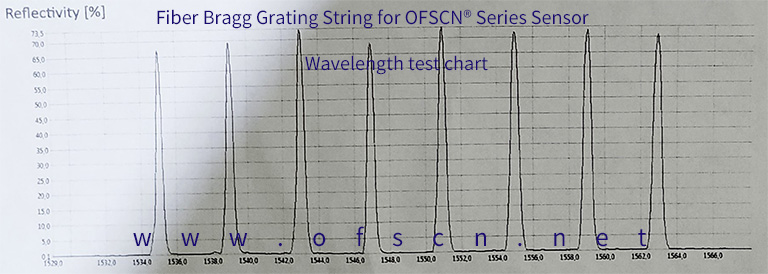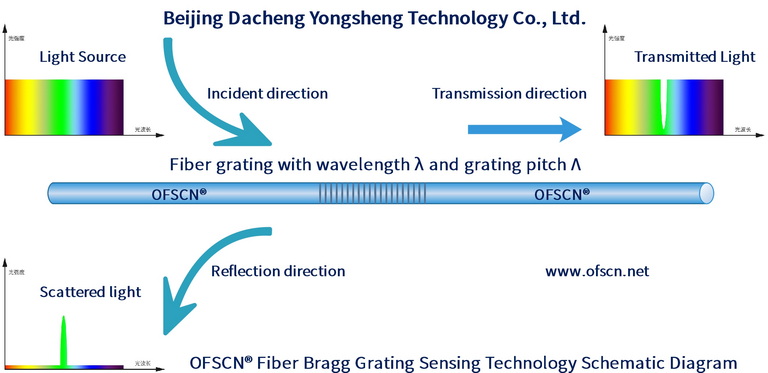This article introduces the concept of Fiber Bragg Grating (FBG) and explains how FBG works. It explains the principle of FBG using the Bragg condition formula and provides corresponding physical diagrams of FBG sensors.
It also highlights that many OFSCN® capillary seamless steel tube fiber bragg grating sensors, including FBG temperature sensors (thermometers), FBG strain sensors (strain gauges), and FBG stress sensors (tensile gauges), are made using FBGs. The article presents the packaging principle of FBG sensors as well.
1. What is a Grating?
An optical device composed of numerous parallel slits with regular spacing is called a grating. The most common type is an equidistant grating with slits of the same width and spacing.
 |
|
Figure 1 |
These gratings are often fabricated on glass plates, metal sheets, or plastic boards. The slits can be either opaque or partially transparent, while the smooth regions between the slits are typically transparent.
Well-designed gratings can have thousands or even tens of thousands of slits within a 1 cm width. Since the grating spacing (grating period) is close to the wavelength of light, diffraction or transmission of light waves occurs.
Gratings that utilize transmitted light diffraction are called transmission gratings, while those that utilize reflected light diffraction, such as those with parallel slits on a metal-coated surface, are called reflection gratings.
2. What is Optical Fiber Grating)? What is Fiber Bragg Grating (FBG)?
When the regular spacing of the aforementioned parallel slits is inscribed on the core of an optical fiber using photosensitive materials, it becomes a fiber Bragg grating (FBG).
Optical Fiber Grating with uniform and consistent grating distance (grating cycle), also known as a FBG, the reflected wavelength is extremely narrow, and the distance between the reflection points is always the same. The grating includes numerous reflection points for specific wavelengths.
FBG can be produced using methods such as UV exposure with a mask, chemical etching, or femtosecond laser point-by-point writing. The following are schematic and physical diagrams of FBGs:
 |
|
Figure 2 |
 |
|
Figure 3 |
 |
3. What is Fiber Bragg Grating String/Array?
A flexible characteristic of FBGs is the ability to achieve multi-point sensing. In theory, multiple FBGs with different wavelengths can be inscribed within a single sensor, allowing for distributed measurements of one or more physical parameters. The fiber with multiple inscribed FBGs is called a fiber Bragg grating string/array (FBGs) (corresponding to OFSCN® capillary seamless steel tube Distributed Fiber Bragg Grating Sensors).
For example, Figure 5 shows a fiber with 9 different-wavelength FBGs, enabling simultaneous measurements at 9 different points.
 |
| Figure 5 |
 |
|
Figure 6 |
 |
|
Figure 7 (The upper figure shows the wavelength distribution of an FBG array with 8 different wavelengths on an optical spectrum analyzer.) |
4. Fiber Bragg Grating Principle
When two reflection points are precisely matched according to the Bragg condition, the optical signal with the corresponding wavelength is reflected by the grating, while other wavelengths are not significantly reflected.
 |
|
Figure 8 |
By connecting an FBG interrogator, the wavelength of the independent reflected wave can be measured. When a FBG is subjected to stress or temperature changes, the grating spacing (grating period) and the wavelength of the reflected wave change. These changes can be measured by analyzing the reflected wavelengths.
The wavelength change of a FBG is related to both the strain and temperature changes and can be expressed by the formula: ΔλB = λB(1 - Pe)Δε + λB(αf - ξ)ΔT.
(1). Temperature Measurement Principle of FBG - FBG Temperature Sensor Principle (FBG Thermometer) - Length Change due to Thermal Expansion and Contraction
In the environment where an FBG is located, temperature changes cause periodic variations in the grating spacing (Λ) of the FBG, which can be attributed to thermal expansion and contraction.
Using an FBG interrogator, the reflected wavelength (λB) of the FBG can be measured. Since there is a relationship between the reflected wavelength (λB) and the grating spacing (Λ), expressed as λB = 2neffΛ, where neff is the effective refractive index of the fiber, the temperature of the FBG can be determined by analyzing the reflected wavelength. This is the measurement principle of grating temperature.
(2) . Stress Measurement Principle of Fiber Bragg Grating (FBG)-FBG Stress Sensor (FBG Strain Gauge,FBG Tensile Gauge, FBG Pressure Gauge, FBG Rebar Gauge) - Length Change Itself:
Similar to temperature changes, variations in force can also cause changes in the grating pitch (grating period) of the Fiber Bragg Grating (FBG). In simple terms, it can either stretch or compress the FBG.
By using a FBG interrogator, the reflected wavelength of the FBG can be measured. Since there is a correlation between the reflected wavelength λB and the grating pitch Λ of the FBG, expressed by the formula λB = 2neffΛ, where neff is the effective refractive index of the fiber, the applied tension or pressure on the FBG can be determined by analyzing the reflected wavelength. This is the principle behind FBG's ability to measure stress.
(3). Strain Measurement Principle of Fiber Bragg Grating (FBG)-FBG Strain Sensor (FBG Strain Gauge) - Length Change Itself:
Whether it is the temperature-induced changes or the changes caused by applied force, the ultimate manifestation is the change in length (strain) of the FBG. In the formula λB = 2neffΛ, the grating pitch Λ represents the length of the FBG on a small scale. Therefore, FBG can be used to measure strain.
5. Why is Packaging Important for Fiber Bragg Grating (FBG)?
The sensing units of OFSCN® capillary seamless steel tube fiber bragg grating sensors from DCYS, mostly consist of Fiber Bragg Gratings (FBGs) encapsulated in seamless steel tubes.
The main reason for using seamless steel tube packaging for FBGs is that FBGs are very fragile, and the fibers that carry the FBGs are also delicate. Without proper packaging and protection, the FBGs are almost unusable in practical applications. It is necessary to protect the FBGs and manufacture robust FBG sensors for their use in various challenging environments. This is precisely what we are good at.
 |
|
Figure 9 |
|
|
| Figure 10 |
Our philosophy is: "OFSCN®, make optical fiber stronger!"

